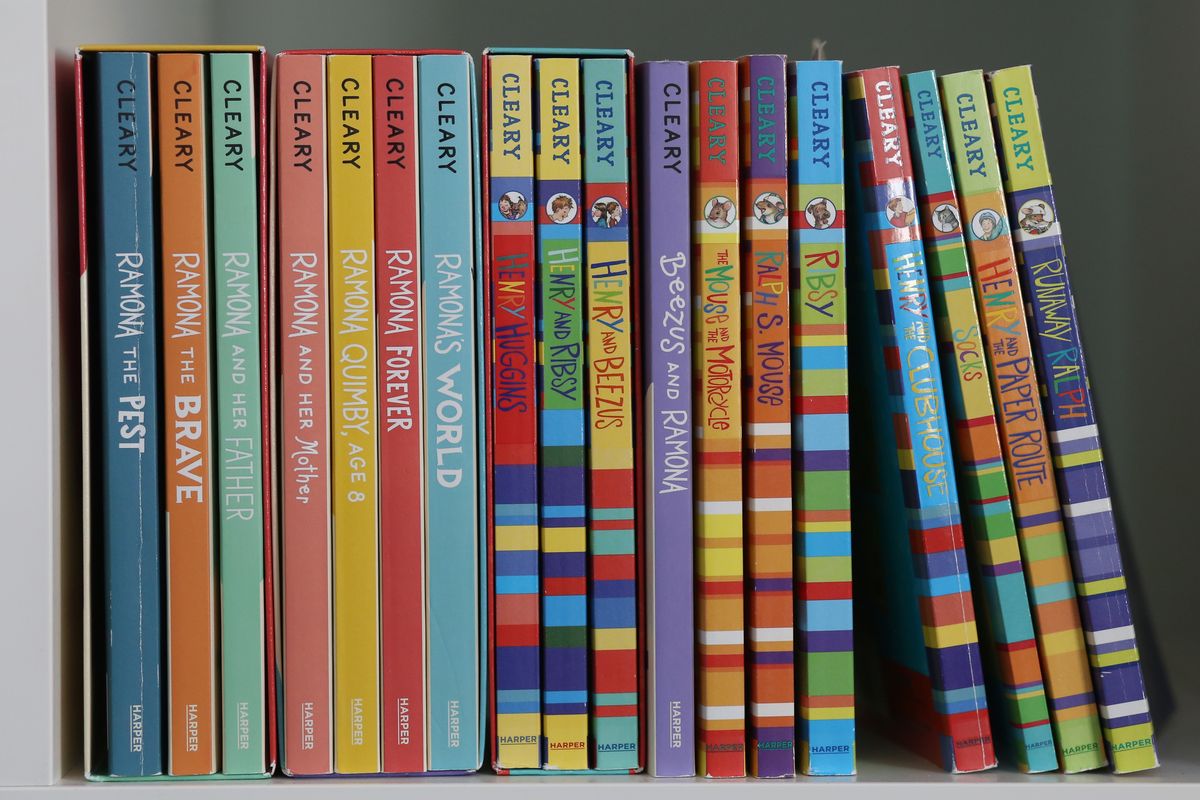Beverly Cleary taught girls to make a brave demand: Love me for how I am
A collection of books by Beverly Cleary on a home bookshelf. The beloved children’s author, whose characters Ramona Quimby and Henry Huggins enthralled generations of youngsters, died on March 25. (Anthony McCartney/Associated Press)
Among the many indignities endured by Ramona Quimby is a midyear progress report sent home by her first-grade teacher, which informs her parents that she is a busybody and needs “to learn to keep her hands to herself.”
Ramona, devastated and misunderstood, tries to explain: She wasn’t bugging her seatmate, she was trying to help him. She was doing her very best.
There, in the penultimate chapter of “Ramona the Brave,” our 6-year-old heroine collapses in tears. Her mother pats her back and murmurs, “What are we going to do with you?”
And then: “With red eyes, a swollen face and a streaming nose, Ramona sat up and glared at her mother. ‘Love me!’ ”
Ramona, sigh. Headstrong and exasperating and grubby and irrepressible. She tries to crack a hard-boiled egg on her head, and it turns out that the egg is raw. Her sheep costume isn’t finished in time for the Nativity play at school, so she is forced to go onstage in her pajamas.
The family’s cat passes away, and though he never liked Ramona, she still frets over the correct liturgy for a feline funeral.
Beverly Cleary, whose death at 104 was announced March 26, first introduced Ramona as a minor character in a different children’s novel.
But over the next 50 years and eight books she became her own protagonist, a real girl suffering the real problems of childhood in all their smallness and enormity.
“She does not suffer fools. She is full of vim and vigor,” wrote Amy Poehler in the foreword of a recently rereleased Ramona novel.
“Ramona was a pest! She was irascible and uncompromising! She was allowed to be angry and not afraid to stand up to boys!”
Today, these traits would be unremarkable for a female literary heroine – standard, even, obsessed as we are now with the hazy notion of “strong female characters.”
In 1950, when Ramona made her first appearance, they were not unremarkable; they were trailblazing.
Cleary took every attribute that girls were then warned away from – bossiness, brashness, hot temper – and she tucked them all into one character. And then she made that character into an inspiration.
“Upon a cursory read, it might be tempting to describe Ramona as mischievous, but Cleary herself has protested against this accusation, and with good reason,” read a LitHub analysis of the character from a few years ago.
“Ramona loves the world with ferocity; she does not so much want to disturb it as she yearns to discover, to turn it over, examine every piece and crook and marvel at why each creature, commodity and substance exists the way it does.”
First lady Jill Biden put it more simply. “Millions of girls saw themselves in Ramona Quimby,” she tweeted upon learning of Cleary’s passing. “Thank you from all the ‘pests’ out there.”
To identify with Ramona Quimby was to understand that the world didn’t fit you yet, but it might one day. To hold your loved ones to high standards and yourself to even higher ones.
To belt out “99 Bottles of Beer on the Wall” at top volume in the middle of a rainstorm and to – just once, just for the bragging rights – get all the way down to one bottle of beer.
To identify with Ramona Quimby was to never question whether you were too improper, too loud, too much. To insist on a truer reflection of your burgeoning self than a princess in a fairy tale.
To demand that space be made for you, and for all the girls like you, who have more than once heard someone murmur, “What are we going to do with you?”
Love me.
Love me.
What a brave and beautiful request. Some days we are all snot-filled and red-eyed, wishing the world would better understand us.
Some days we are not princesses or princes; we are grubby, unyielding, irrepressible children, asking for the one thing every one of us deserves.

